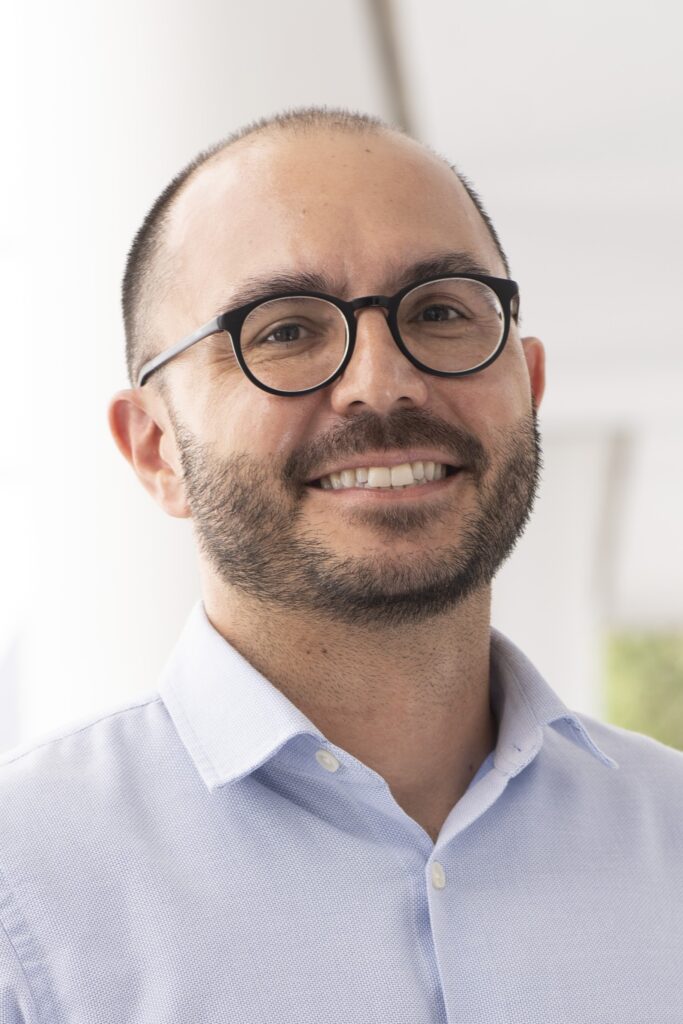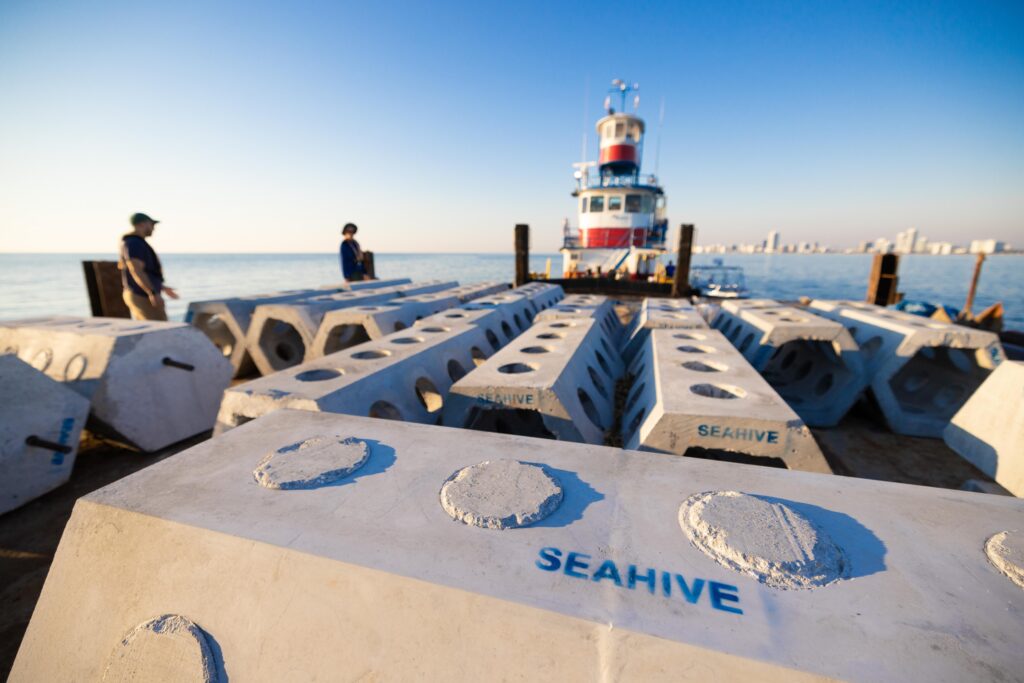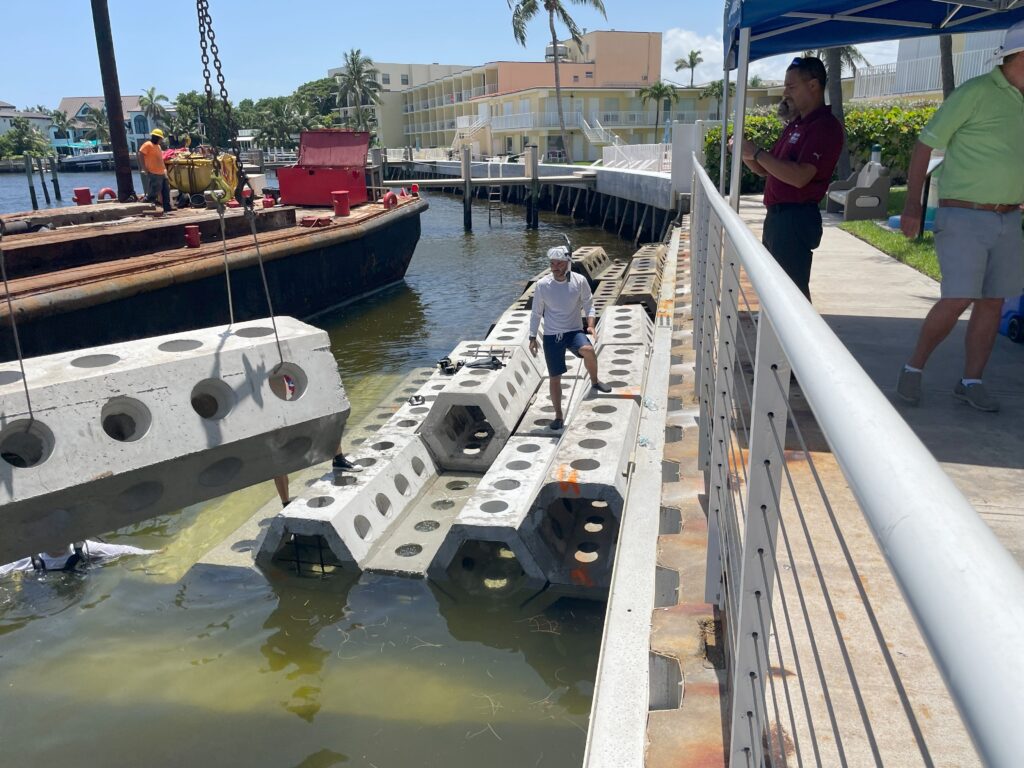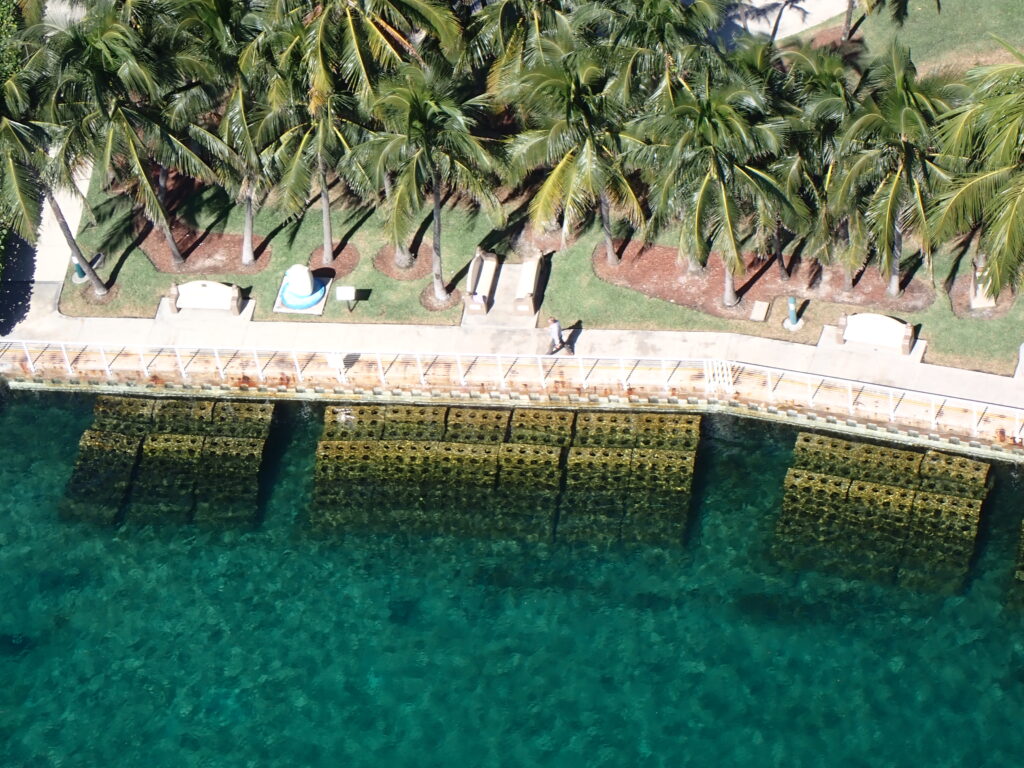By Kristan Reynolds, The Invading Sea
The following Q&A was conducted with Landolf Rhode-Barbarigos, an associate professor in the Department of Civil and Architectural Engineering at the University of Miami. Rhode-Barbarigos is part of the university team that developed a perforated, hexagonal concrete unit called SEAHIVE, which prevents coastal erosion while also allowing marine life to thrive in and around it. This interview has been edited for length and clarity.
What is SEAHIVE and how does it work?

SEAHIVE is basically a shoreline protection system that can be applied to our shorelines but also to coastal, marine, estuarine and riverine environments. It is made out of sustainable concrete mixtures and has this hexagonal pattern. The units are basically hexagonal prisms — they’re hollow, they have some perforations on the side.
When we stack them horizontally or vertically, we create a system that has some porosity and allows the water to go in. The water can go in and dissipate wave energy inside the system, rather than bouncing back. The other thing that happens when we stack them like that is the system can actually accommodate sediment, so that we can fill it and allow marine life or riverine life to develop.
What inspired the invention of SEAHIVE and what did the development process look like?
The SEAHIVE was born in the context of a National Cooperative Highway Research Program in collaboration with the Florida DOT (Department of Transportation). The idea was to find a sustainable and eco-friendly (invention). Soon, we realized that this can go beyond the development; They can be used for other applications from the living shoreline to the hybrid coral reefs and living breakwaters.
The inspiration was drawn to a certain extent from nature, but also through the discussions that we had with the different inventors, including Steve Nolan from the Florida Department of Transportation. … At the beginning we tested the different shapes and different porosities and how we get this processed in order to understand how the system will interact with the waves. After that, we tested the system, and we were extremely lucky to work with communities that allow us to have a platform to have those pilots. …
What benefits does SEAHIVE have over previous approaches to coastal infrastructure?

The advantages of SEAHIVE, I would say, is the flexibility, modularity and the advances that we’ve seen in terms of material and structural performance, combined with its wave energy dissipation. That may be the most important one: The fact that we actually dissipate wave energy … which is not typically offered by many systems.
Also, the fact that within the system, we can accommodate some ecosystems — this can be the corals that we can plant on top, or the mangroves that we can accommodate or anything else that actually can find home in a SEAHIVE system. The structural complexity, the surface roughness, the material proposition that we have kind of makes it eco-friendly.
What is the impact on the local ecosystems where the SEAHIVEs are placed and are there any concerns for damage or disruption of those ecosystems?
I think that any time we do an intervention where you have a human made component, there is a little bit of impact. The thing is that we try to minimize our impact, or in some cases, make our impact positive. … We’ve seen some good points in terms of fish habitat; we see that we are on the right track, but it needs a lot of long term monitoring so that we can call it a win. …
Will the SEAHIVE structures be able to protect Florida’s coastlines from increasingly intense storms due to climate change?
To protect Florida or protect the other locations, we need infrastructure installations. SEAHIVE gives us the technology. The pilots give us basically the data points that we need, so if this actually can scale up, we will need a lot of SEAHIVEs and this would be towards an infrastructure-level investment, but the SEAHIVE is one of the technologies that can contribute in protecting Florida in an effective and sustainable way.
Can you share any insights about the progress and success of the SEAHIVE projects that have already been installed?
We have been permitted in three projects to have been partially completed in the sense that we’re always working on them.
The first one was offshore of Miami Beach, for the artificial hybrid coral reef. There are three stacks of SEAHIVEs that have been deployed and populated with corals. This is a project that was funded by the city of Miami Beach and the U-LINK program of the University of Miami. That is a project that we monitor closely because it also ties to our ongoing research …

The second installation is up in Broward County in Pompano Beach. This is in collaboration with Pompano city, the county, but also a nonprofit — Shipwreck Park … They wanted to create a marine environment with mangroves. We had this discussion with them about integrating SEAHIVE and providing them the platform to do that … so we’ve been working with them in the installation, and now we’re in the process of planting the mangroves.
It should be noted that we are doing surveys, pre-installation and post-installation, so that we can observe the differences before. As an example, in Wahoo Bay (the third site), we focused on fish abundance and diversity. This is, I would say early signs, but the data shows that we have a lot more fish and this is a good sign for us because they are an indicator of habitat creation.
Same thing in Miami Beach. In the overall site there, in the pilot, there were more than a thousand corals transplanted. Despite the increasing temperature, we had fortunately 80% of survivorship, which is a great sign and kudos to my colleagues who selected the right type of corals and so on. These are all good signs that we create habitat while the structure is also performing in terms of engineering. …
What is the total envisioned scale for the installation of SEAHIVE structures?
These installations are typically on the smaller end. So we’re talking about anything from 20 feet to up to 200 feet, but the idea is that these installations allow you to actually get good data in terms of performance. … Then, we can make the argument on how we can scale up.
Scaling up is critical and it is a big challenge, not only on the manufacturing side, but also on (the question of) how would something like this perform? Having this preliminary data is critical in order for us to have the confidence but also making an argument with stakeholders about the performance of SEAHIVE and any other solution.
Are there any plans to further advance or adjust the SEAHIVE design?
We’re always looking at adjustments, new applications, SEAHIVE 2.0 or 3.0. There is always ongoing research on those. We have an SBR (Small Business Reserve) with 1Print, which is our 3D printing manufacturer developing some ideas on that front. We have other ideas for erosion control …
There’s a lot of research going on and not only from my side but also other research teams. I think what is interesting here is that there is also a collaborative spirit where we discuss how SEAHIVE made it here, and SEAHIVE shows one success story maybe, and we want to see more of them. We need multiple solutions and SEAHIVE might not always be the answer to a problem, so we need portfolio solutions to actually make it. … We understand that we need to take action, so taking the best action we can is critical.
What kind of impact is SEAHIVE creating in the local community?

We do have in South Florida a great community for shoreline protection, so that’s one aspect, but there’s also another aspect, which is the education of the young engineers. With SEAHIVE, I have the opportunity to go in class or go in front of younger minds, some are even younger than university level, and inspire them and tell them, “Look, there are engineering solutions that work with nature …”
I think that this is the other success story: the attention that SEAHIVE has received, not only from the stakeholders and engineers, but also from people that actually can relate to nature more than can relate to the engineering side and understanding that they are success stories to a certain extent that can inspire the younger generation … I think this is important because they can see that there is hope, it’s not all doom and gloom.
Kristan Reynolds is a Florida Atlantic University senior majoring in multimedia journalism and minoring in communication studies who is reporting for The Invading Sea during the summer 2024 semester.
Sign up for The Invading Sea newsletter by visiting here. If you are interested in submitting an opinion piece to The Invading Sea, email Editor Nathan Crabbe at ncrabbe@fau.edu.



